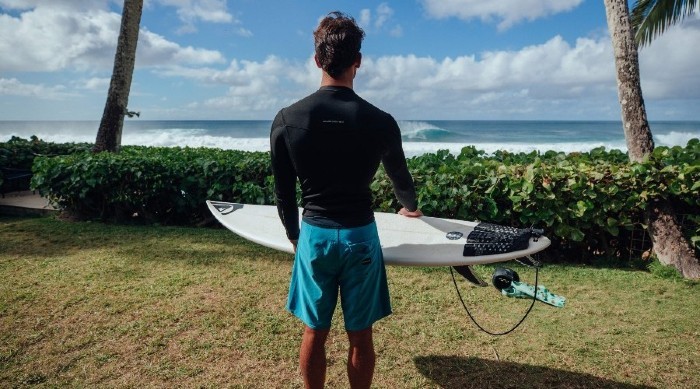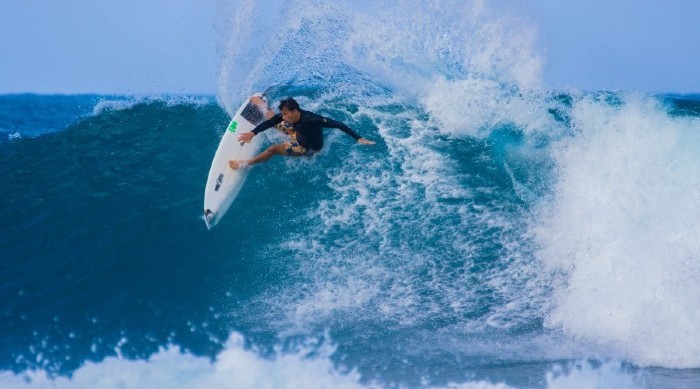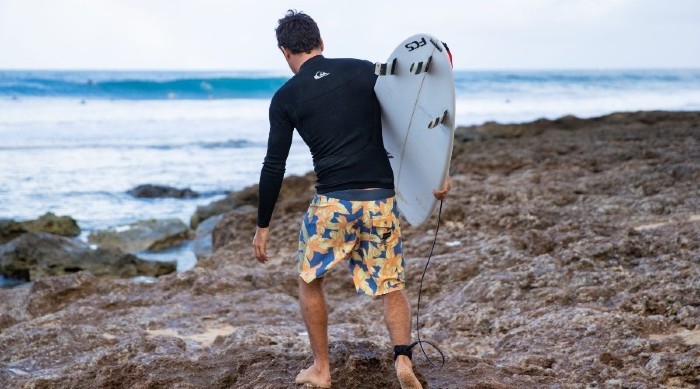
SHOP
Free Shipping & Returns for Loyalty Members
Sign in to get your rewards, check your points balance or access free shipping.
QUIKSILVER FREEDOM BENEFITS MEMBERS
- GET FREE SHIPPING + RETURNS! Join Now | Sign In
SATURN COLLECTION
Inspired by the Y2CORE surf scene Shop Now
FREE DUFFLE BAG
- Spend $150 or more on full price* Use Code: FREEBAG Shop Now
THE ORIGINAL BOARDSHORT COMPANY
Original is back then. Original is right now. Shop Boardshorts
Expert Guides :

The reliable rashguard (also known as a rashie, rash shirt or even vest) is a time honoured piece of surfing equipment we all use and abuse in our surfing journey. The rashie is a brilliantly thin shirt constructed from quick-drying synthetic materials that block harmful UV rays.
While it’s generally used in the water, for surfing/swimming, etc, there’s no rules about using it on land as well while frolicking in the sunshine. They are an essential piece of equipment if you intend to spend any time around the water, including beach time, pool fun or just out and about in the sun.
SHOP RASHGUARDS
To be honest, you could wear it everyday all day if you really wanted to. But the ideal time to be wearing one is anytime you’re out in the sun and you want to protect yourself (and your children) from the harmful effects of UV rays.
Whether you’re surfing, sunning, paddling, hanging at the beach or on a boat, wearing a rash guard gives a lot of benefits. Obviously the first one is sun protection, but then there’s also skin protection from wax or traction on your surfboard. You can also wear one for extra warmth under your wetsuit when surfing in winter.
Did you know that Rashguards originated in Australia from surfers wanting to protect themselves from the sun, surf and sand!
Constructed from a (ideally recycled) synthetic poly-elastane blend materials, Rashguards are stretchy, durable, quick drying and feature UV blocking properties. Quality construction is key to ensuring you get a comfortable and durable rash guard, they are designed to fit tight (snug) and close to your body, this allows it to move with you and avoid any restrictions when on the beach or in the water. And it’ll also help in reducing any chaffing when paddling/swimming. Make sure your rashguard has flat lock stitching, be made from recycled properties and also to be chlorine resistant (for those pool days!).
If a rash guard feels too tight for you, then you also have the choice of surf/swim shirts that feature a more relaxed fit (like a t-shirt). They are essentially the same as a rash guard, just a looser fit and better look if you’re walking the streets. But keep your eyes peeled for any swim shirts that use solution-dyed fabrics… Why? This technique reduces water consumption, energy and ultimately, the impact on the environment.
Much like we use sunscreen and its SPF ratings to protect us from the sun, the main reason we use rash guards is the UV protection they offer. To better explain what that is, here’s a little science lesson:
A rash guard that has a UPF rating of 50 means that just 1/50th of the sun's UV rays reach the skin. SPF is based on the time it takes for UV-exposed skin to redden; if you burn after 20 minutes, if used correctly, an SPF 15 sunscreen may protect your skin 15 times longer.
Using both together really helps protect your body from any sunburn, etc. But be sure to check your rash guards specifications before buying, check what level of UPF it offers and always apply sunscreen to any areas that aren’t covered by your clothing.

Rashguards generally start as a base layer and you can either leave at that or build on that with more layers (thermal vest, wetsuits, etc).
Warmer water and warmer environments generally means you’ll be wearing boardshorts and the rash guard. It’s your choice whether to get a short sleeve or long sleeve one, but we suggest the long sleeve options as it gives you more protection. You can even grab a long sleeve hooded rash guard for those days where you’re out in the water and under the sun all day long.
Colder water, colder environments generally mean you’ll be wearing a rash guard under your wetsuit as another way to stay warmer longer (and even hold off any rashes from your wetsuit).
Colour options are plenty, and subjective to what you love. We will mention that it’s probably smarter to get a lighter colour if you’re wearing it as your base layer (dark colours attract sun/UV rays). If you’re wearing it under your wetsuit darker colours are fine.

Sign up to get all the latest news and exclusive offers.
(*) Offer valid online for new members - Full conditions are available in welcome email
Your personal information will be processed by BOARDRIDERS in accordance with the BOARDRIDERS Australia Privacy Policy for the purpose of providing you with our products and services and keeping you informed on our news and collections in connection with our brand QUIKSILVER. You may unsubscribe at any time if you no longer wish to receive information or offers from our brand. You may also request to access, correct, or delete your personal information.
©2023 Quiksilver, Inc. All rights reserved.
Do you have something you'd like to share with us, or a question that calls for our attention? Call or chat with one of our representatives.
1800 090 402
9:00am – 5:00pm AEST Monday – Friday
*Closed Weekends and all National / State / Region Public Holidays
Get immediate answers to our most frequently asked questions.